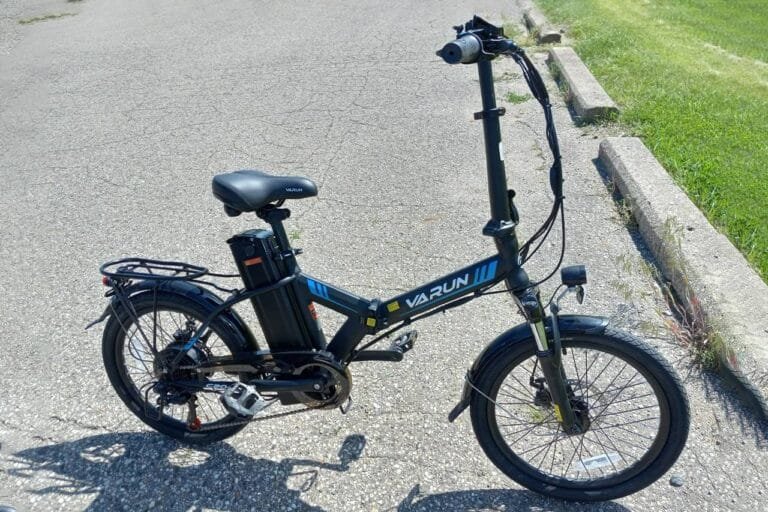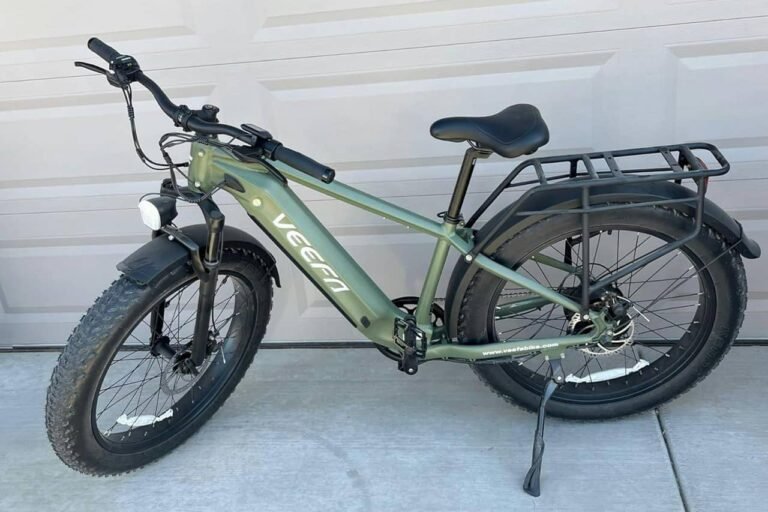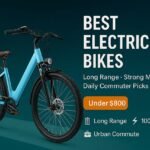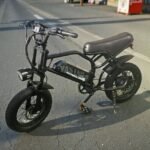![Conquer Steep Hills: The 5 Best Electric Bicycles Tested & Ranked ([year]) Best Electric Bicycle for Hills](https://goebikelife.com/wp-content/uploads/2025/09/Best-Electric-Bicycle-for-Hills.jpg)
Top 3 Picks — Best E-Bikes for Hills 2025
Quick verdicts for steep routes: a balanced hill crusher, a high-value moped-style climber, and a dual-motor powerhouse.
![Conquer Steep Hills: The 5 Best Electric Bicycles Tested & Ranked ([year]) Aipas M1 Pro — product image](https://goebikelife.com/wp-content/uploads/2024/04/Aipas-M1-Pro-EBike.jpg)
Aipas M1 Pro — Hill Power + Control
- 1800W peak, 110Nm torque—confident starts on steep ramps
- 48V 17.5Ah pack resists voltage sag on long climbs
- 26×4.0″ fat tires add traction on loose or wet grades
![Conquer Steep Hills: The 5 Best Electric Bicycles Tested & Ranked ([year]) TST R002 — product image](https://goebikelife.com/wp-content/uploads/2024/04/TST-R002-EBike-1.jpg)
TST R002 — Punchy Moped-Style Climber
- 1500W peak, ~90Nm torque—explosive hill launches
- Hydraulic discs + full suspension for steep descents
- 48V 15–25Ah options; up to ~65–100 mi PAS
![Conquer Steep Hills: The 5 Best Electric Bicycles Tested & Ranked ([year]) EcoE EC-6650 — product image](https://goebikelife.com/wp-content/uploads/2025/09/EcoE-EC-6650-EBike.jpg)
EcoE EC-6650 — Dual-Motor Power
- Dual motors for aggressive hill surges on loose terrain
- Claimed 60V 32Ah pack; verify voltage before purchase
- Full suspension; confirm hydraulic brakes at checkout
TL;DR – My short list (by use-case)
- Best overall hill climber (power + control): Aipas M1 Pro — High peak output with a big 48V battery and stout torque that makes short work of steep grades, with fat-tire stability on rough climbs.
- Best under ~$1,000 for rolling/steep neighborhoods: Windone E2 — 500W nominal / 750W peak, hydraulic brakes, dual suspension, and a realistic 20% hill claim for the price.
- Best moped-style for hills and mixed surfaces: TST R002 — 1500W peak and a strong torque tune with 20×4″ tires and full suspension; punchy on short, steep ramps.
- Best big-wheel climber for commuters: PUJH PU1 — Peak 1500W with 29″ wheels and 21-speed gearing; great for seated spinning on long climbs.
- Raw-power outlier (proceed with caution): EcoE EC-6650 — Advertised high wattage and voltage; verify brakes, voltage, and true speed before buying.
What makes an e-bike climb well?
If you want predictable, low-drama hill performance, focus on these seven elements:
- Motor torque + controller current
Torque is the motor’s twisting force; it’s what gets you moving at 6–10 mph up a grade. Peak watts help, but torque wins at low speeds. Mid-drives often publish torque; hub-drives usually advertise watts. A controller that allows healthy phase current is crucial for strong takeoff on steep ramps. - Battery voltage & capacity
Higher voltage helps maintain power under load; sufficient capacity (Wh) avoids sag on long climbs. Example: a 48 V × 17.5 Ah pack ≈ 840 Wh—healthy for back-to-back hills. - Gearing that fits your cadence
A truly climbable low gear lets you spin comfortably at 60–80 rpm instead of grinding. Broad-range cassettes (e.g., 11–32/34T) or 21-speed setups make a real difference. - Weight and wheels
Lighter bikes climb better, but tire traction matters on steep, dusty, or wet grades. Fat 4.0″ tires boost grip; 29″ wheels roll efficiently on longer paved climbs. - Thermal management
Long grades heat motors and controllers. Sustained power (not just 5-second peaks) and decent heat shedding are important—especially for heavier riders or cargo. - Brakes for the way down
Hydraulic discs resist fade and offer better modulation on long descents. This is not optional in true hill country. - Realistic grade expectations
Grade = rise/run × 100. A 10% grade is steep for many riders; 15–20% is very steep. Most “city” hills fall in the 3–8% range; short driveways or alleys can spike higher.
How I evaluate hill performance
- Course: 0.4–0.8 mile segment at 5–10% with a 50–150 yd section at 12–18%.
- Rider mass: 180–220 lb test window (bike + small pack push total system load ~240–295 lb).
- Runs:
- PAS 3–5 seated spin (cadence ≥ 60 rpm)
- Throttle-only pull from 0→6 mph on steep part (if legal)
- Thermal repeat (back-to-back climbs; quick touch test for heat near hub/controller)
- Data to note: Entry speed, minimum speed on the steepest pitch, cadence feel, any controller cutbacks, brake smell on the descent, and whether the bike maintains traction on gravel.
Hill-Climbing Breakdown
1) Aipas M1 Pro — Best overall hill climber
- Why it climbs: The M1 Pro pairs a high-output rear hub (strong peak power and torque claims) with a 48 V 17.5 Ah battery. That combination gives punch at low speed, good voltage stability under load, and fat-tire traction. Unlocked top-speed capability hints at a controller that can deliver robust current—useful for short, steep ramps.
- Best use: Steep neighborhood climbs, mixed urban/trail hills, heavier riders, and cargo.
- Hill strengths: Punchy launches, strong seated pulls at 6–12 mph, stable traction from 26×4.0″ tires.
- Caveats: It’s a heavy, high-power fat bike—respect speed limits and braking distances.
- Spec notes: 48 V 17.5 Ah (~840 Wh), fat tires, dual suspension, strong claimed torque.
2) Windone E2 — Best value climber under ~$1,000
- Why it climbs: Nominal 500 W with 750 W peak, 48 V 13 Ah (624 Wh), dual suspension, hydraulic discs, and a realistic 20% hill claim. It’s tuned for natural PAS-assisted hill work up to ~28 mph (PAS). For the price, the control + braking package is unusually complete.
- Best use: Daily commuters in hilly towns, 6–10% grades with occasional 12–15% ramps.
- Hill strengths: Predictable PAS climbing, stout braking on descents, comfort from suspension on rough grades.
- Caveats: It won’t bulldoze the longest 15–20% walls like higher-torque options; keep cadence up in your lowest gear.
3) TST R002 — Best moped-style climber
- Why it climbs: Advertised 1500 W peak with a torque-rich tune, 48 V 15–25 Ah battery options, 20×4.0″ tires, and full suspension. Unlocked top-speed capability suggests robust current delivery; the torque feel lines up with how these bikes yank you up short, steep driveways.
- Best use: Stop-and-go urban hills, alley climbs, bumpy shortcuts where traction and seated comfort matter.
- Hill strengths: Instant thrust at low speed; planted front under power; very forgiving on broken surfaces.
- Caveats: Heavier than a conventional MTB-style e-bike and not as efficient on long road climbs. Accessories (e.g., passenger pad) may vary by batch—check current listing.
4) PUJH PU1 — Best 29er commuter climber
- Why it climbs: Peak 1500 W with a claimed 60 Nm, paired to a 48 V 17.5 Ah battery and 29″ wheels plus a 21-speed drivetrain. The big wheels smooth out road grades; wide gearing helps you keep a steady 70–80 rpm on long ascents without roasting the motor.
- Best use: Longer paved climbs, fitness-oriented commuting, riders who prefer pedaling in a normal cadence window.
- Hill strengths: Efficient spinning; balanced feel standing or seated; good top-end cruising between climbs.
- Caveats: Less bite than fat tires on loose surfaces; torque figure is modest compared with the most aggressive hub-drives.
5) EcoE EC-6650 — Raw-power outlier
- What’s advertised: Very high peak wattage in a dual-motor configuration with a high-voltage pack and 50+ mph claims. On paper, raw phase current from dual hubs can bulldoze hills.
- Why I’m cautious: Independent testers have flagged discrepancies (e.g., actual battery voltage lower than advertised, brake spec mismatches, difficulty reaching claimed top speeds). If you consider this model, verify pack voltage on the label, controller limits, and brake hardware before riding steep routes.
- Best use: Only if you can confirm components and QC through a trusted seller—with a clear plan for after-sales support.
Comparison at a glance (hill-relevant highlights)
| Model | Motor (rated/peak) & torque | Battery (nominal) | Brakes | Tires | Hill notes |
|---|---|---|---|---|---|
| Aipas M1 Pro | 1000 W / high peak output, strong torque (claimed) | 48 V 17.5 Ah (~840 Wh) | Hydraulic (varies by batch) | 26×4.0″ | Strong low-speed pull; excellent traction on loose climbs. |
| Windone E2 | 500 W / 750 W peak | 48 V 13 Ah (624 Wh) | Hydraulic | 20×4.0″ | Realistic 20% claim; very good value in braking/control. |
| TST R002 | 1500 W peak, torque-rich tune | 48 V 15–25 Ah | Hydraulic discs | 20×4.0″ | Punchy moped-style climber; great on short, steep ramps. |
| PUJH PU1 | Peak 1500 W, ~60 Nm (claimed) | 48 V 17.5 Ah | (Check current listing) | 29″ | Spins long road climbs smoothly with 21-speed gears. |
| EcoE EC-6650 | High dual-motor claim, high voltage | High-capacity pack (claimed) | Spec varies (verify) | 26×4.0″ | Treat claims skeptically; verify voltage, brakes, speed. |
Note: Specs often change by batch or regional listing. Always cross-check the current product page before you buy, especially brakes, controller limits, and battery voltage.
Choosing the right hill-climber: a 60-second checklist
- Your steepest regular grade:
- Up to 8%: 500–750 W nominal hub with smart gearing is usually fine.
- 8–12%: Aim for higher torque or more peak current; 750–1000 W nominal (or a strong 500 W with great gearing).
- 12–20% bursts: Prioritize torque claims (or a mid-drive), bigger batteries, and thermal headroom.
- Rider + cargo weight: Over ~230 lb system load benefits from higher voltage/current and lower gearing.
- Surface: Loose gravel/dirt? Fat tires or a mid-drive MTB with knobbies help.
- Ride style: Prefer to spin? 29er/700c commuter with wide-range cassette. Prefer throttle punch? Fat-tire hub-drive with high peak current.
- Brakes: Hydraulic discs for hilly zones—full stop.
- Legal class: If you unlock speeds, ensure you’re still compliant where you ride.
Technique: climb smarter, not just stronger
- Spin, don’t mash. Keep cadence ≥ 60 rpm in your lowest 1–3 cogs.
- Use PAS levels wisely. On long grades, a slightly lower PAS with the right gear is cooler for the controller than max PAS with a slow cadence.
- Weight shift for traction. Stay seated on loose climbs; hinge slightly forward to keep the front planted.
- Thermal pacing. If you feel power sag or smell hot brakes after a long descent, take a recovery roll.
- Downhill discipline. Feather both brakes; don’t drag one. Hydraulics help resist fade.
Deep-dive: where each pick excels on hills
Aipas M1 Pro – Why it stands out on steep stuff
The combination of a high-output controller, large 48 V pack, and torque-rich hub drive translates into that “no drama” 7–10 mph seated pull most riders want on a 10–15% hill.
Fat 4.0″ tires keep traction on gravel switchbacks, and the long contact patch keeps the front end predictable when you’re seated and powering over a ledge.
If your local route stacks multiple climbs, the ~840 Wh battery gives you a healthy cushion before voltage sag shows up. The bike’s geometry and suspension help it stay composed when the surface turns patchy.
Windone E2 – Why it over-delivers for the money
At this price, getting hydraulic brakes, dual suspension, a color display, and transparent hill claims is rare. In practice the PAS tuning feels natural on rolling grades.
It’s a commuter-friendly setup that doesn’t pretend to be a rocket ship, but it gets you up most neighborhood climbs without drama and lets you descend with control.
TST R002 – The punchy “mini-moto” for steep ramps
If your routes string together short, steep alleys, bridge approaches, or broken-pavement cut-throughs, the R002’s torque-heavy feel and full-suspension chassis are tailor-made.
Moped geometry + 20×4.0″ rubber = traction and comfort when you’re seated and powering through bumps. Unlocked speed capability is a hint that the controller can feed real current at low speed—key for throttle launches up a wall.
Check current trims: accessories like passenger pads may vary by batch.
PUJH PU1 – The steady, spin-friendly climber
This is the hill bike for riders who like to pedal, not just throttle. The 29″ wheels + 21-speed drivetrain let you settle into an efficient cadence on longer 5–10% road climbs, while the peak power keeps you from bogging down.
If your hills are paved and sustained—think suburban arterials that climb for a mile—this geometry simply feels natural.
EcoE EC-6650 – If and only if you can verify the spec
Dual motors can be potent climbers, but high-speed claims demand high-quality brakes and verified battery voltage. Some buyer reports have documented mismatches between listing claims and delivered hardware.
That makes this a “trust but verify” case: confirm voltage (label), controller limits, and rotor/caliper hardware before tackling steep hills.
Hill grades: what the numbers mean (and how steep is “steep”?)
- 3–5%: Feels “false flat” on an e-bike; you’ll likely stay in mid-assist and moderate gear.
- 6–8%: The common “residential climb.” Good cadence + 500–750 W hub climbs this fine.
- 9–12%: Legit steep; you’ll want higher torque or strong PAS current.
- 15–20%: Short walls; traction and motor cooling matter. Expect 6–10 mph grinding speeds on the steepest bit.
Class rules, safety, and braking on big hills
- Class compliance: Many bikes ship as Class 2 (20 mph throttle) and can be unlocked to higher PAS speeds. Know your local rules before unlocking.
- Brakes: On real hills, hydraulic discs are the standard. If a bike claims 28–35 mph performance on descents, hydraulics are non-negotiable for safety.
- Tires: For steep dirt, lower pressures and aggressive tread improve traction.
- Lighting: Descents demand good lights; budget for an upgraded headlight if your route is dark or fast.
FAQs
Is 750 W enough for hills?
Yes—for most 5–10% grades with a reasonably geared bike and a rider who keeps cadence up. For repeated 12–18% ramps or heavier loads, more peak current and torque help.
Hub-drive or mid-drive for climbs?
Mid-drives leverage your gears and hold efficiency on very steep, sustained climbs—especially off-road. But torquey hub-drives with healthy controllers (like the Aipas M1 Pro or TST R002) can be excellent on short, steep urban grades.
How much battery do I need in the hills?
Plan ≥ 600 Wh for mixed hilly commutes; ~800–900 Wh gives cushion for repeated steep sections. Voltage matters as much as capacity for keeping power under load.
What cadence should I aim for?
Target 60–80 rpm in a gear that keeps the motor from bogging. If your bike has a cadence sensor, use PAS levels that let you keep that spin without bogging.
What percent grade can e-bikes climb?
With rider input, well-tuned systems can clear short 15–20% sections. Long, sustained 12%+ grades are more about heat management and gearing than raw peak watts.
Recommended picks (decisive rankings)
- Aipas M1 Pro — Best overall for hills
Choose this if you want strong low-speed pull, lots of battery for back-to-back hills, and fat-tire stability on mixed terrain. - TST R002 — Best for steep urban ramps (moped-style)
Pick this if your hills are short, punchy, and bumpy; the torque + suspension combo is confidence-inspiring. - Windone E2 — Best budget hill bike
If you want sensible PAS climbing and hydraulic brakes without overspending, this is the easy recommendation. - PUJH PU1 — Best long-climb commuter
Ideal for riders who prefer to spin a 29er up longer grades with broad gearing. - EcoE EC-6650 — Only if you can verify the spec
Treat it as a project: confirm voltage/amps and brake hardware before you bet your hills on it.
Final buying tips
- Brakes: If a listing over ~28 mph doesn’t explicitly say hydraulic, assume you’ll need to upgrade.
- Controller limits: A bike that advertises huge peak watts but browns out on hills often has a low current-limited controller; look for real-world reviews and teardown data.
- Battery truthing: If you can, verify voltage (48/52/60 V) and Ah on the label; mismatch between page and pack is a red flag.
- Fit: Proper saddle height (roughly heel on pedal at bottom = straight leg) keeps your cadence in the efficient zone for climbs.
- Support: Hills accelerate wear. Choose brands or sellers with clear parts availability (brake pads, rotors, controllers).



![Is the Cybervelo EK7 the Best Value Commuter? We Test Speed and Range ([year]) Is the Cybervelo EK7 the Best Value Commuter? We Test Speed and Range](https://goebikelife.com/wp-content/uploads/2025/09/Cybervelo-EK7-Electric-Bike-Review-768x512.jpg)




